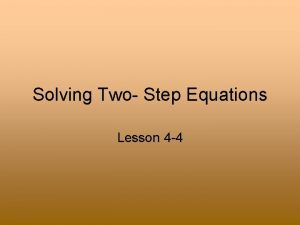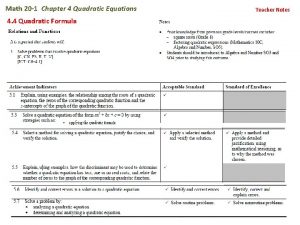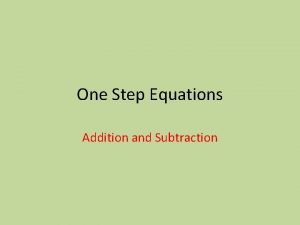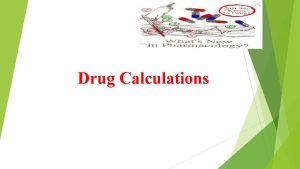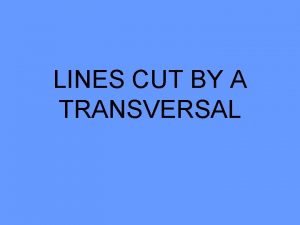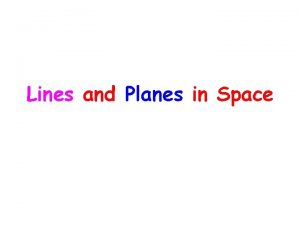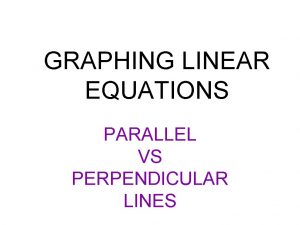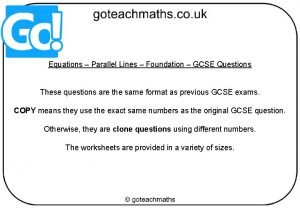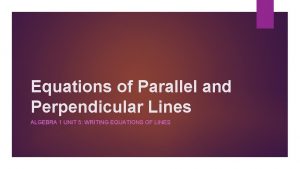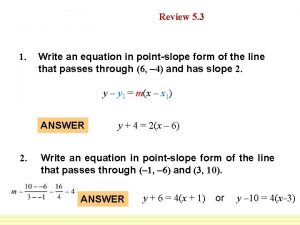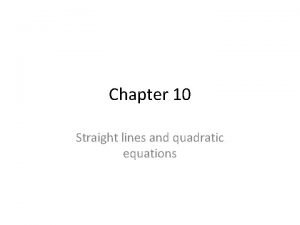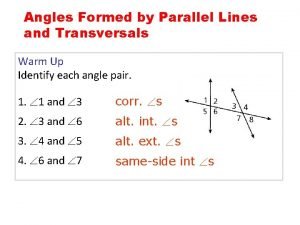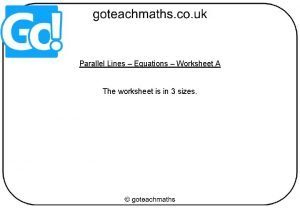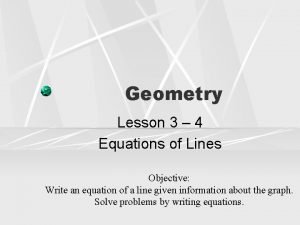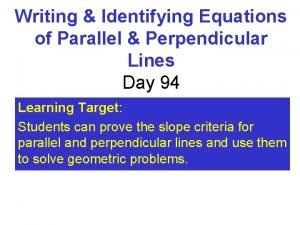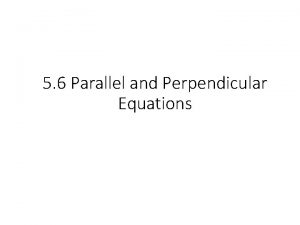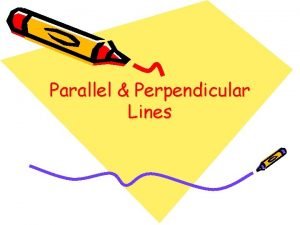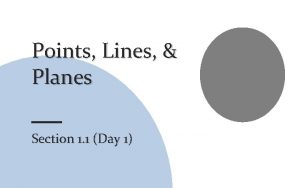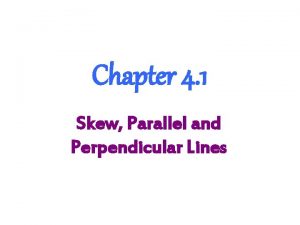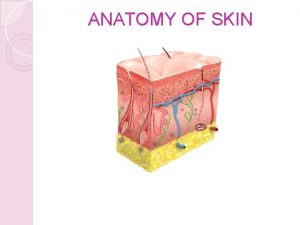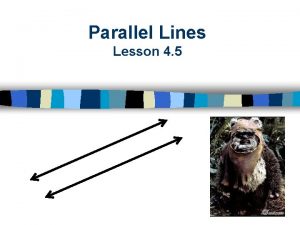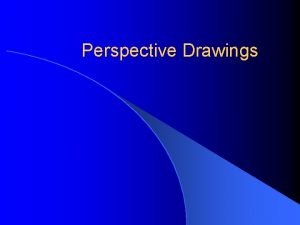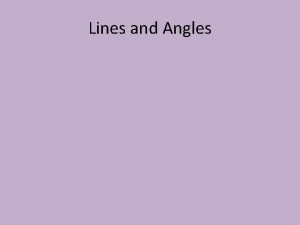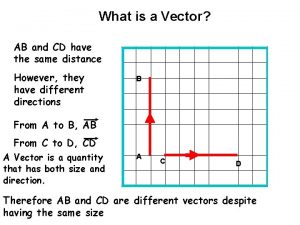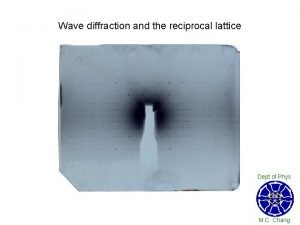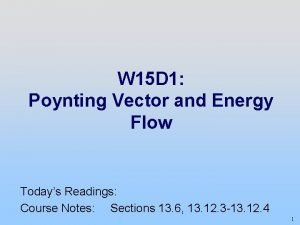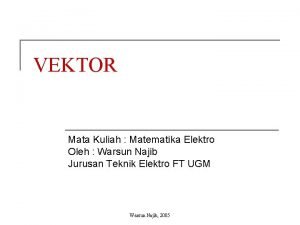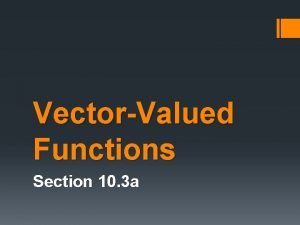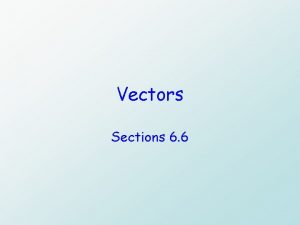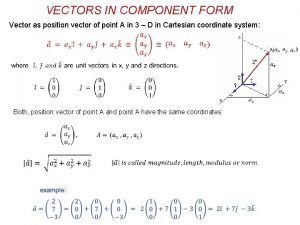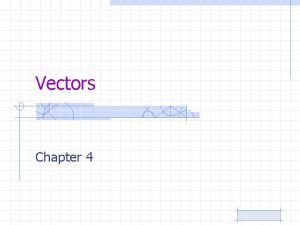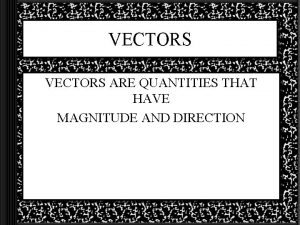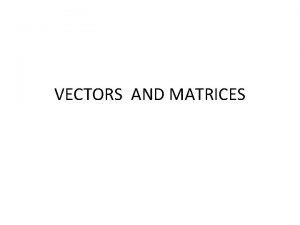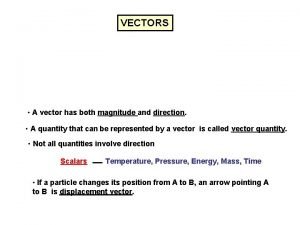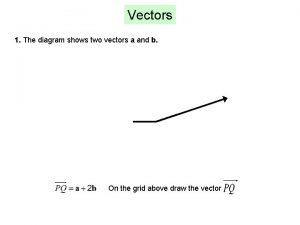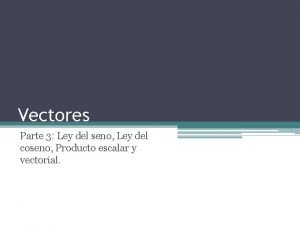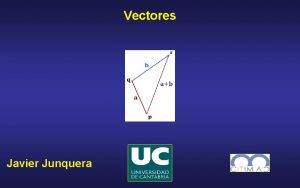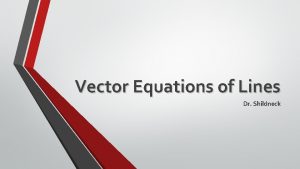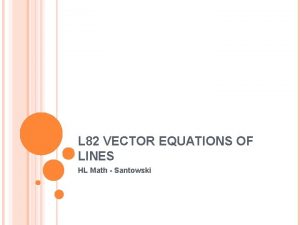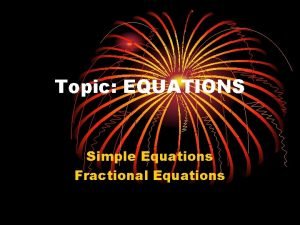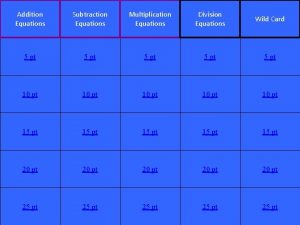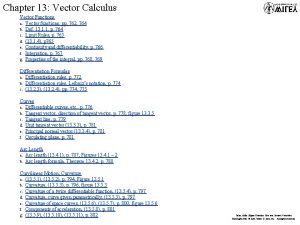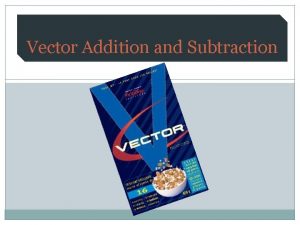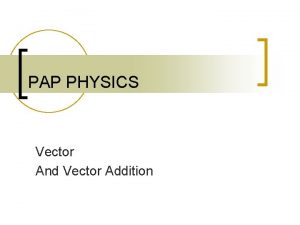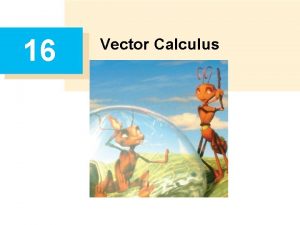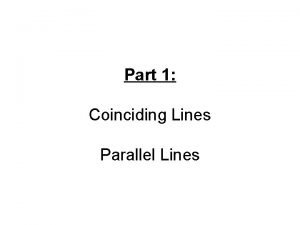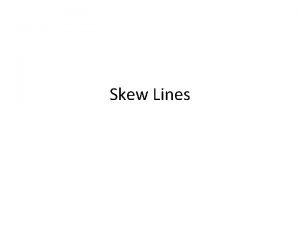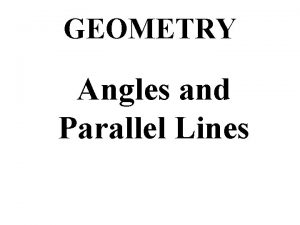L 85 VECTOR EQUATIONS OF LINES HL Math


















































- Slides: 50

L 85 VECTOR EQUATIONS OF LINES HL Math - Santowski

Vector equation of a line 1 a) Find the plane’s coordinate after 1 hour. b) Find the plane’s coordinate after 2 hours. c) Find the plane’s coordinate after t hours. 4 (4, 1) 5 2 10

Vector equation of a line 1 a) Find the plane’s coordinate after 1 hour. (9, 3) b) Find the plane’s coordinate after 2 hours. (14, 5) c) Find the plane’s coordinate after t hours. Vector equation Parametric equation 4 (4, 1) 5 2 10 A coordinate on the line. The vector part of the line.

The vector AB and the vector equation of the line AB are very different things. x x The vector AB x The line through A and B. x ® The vector AB has a definite length ( magnitude ). The line AB is a line passing through the points A and B and has infinite length.

Finding the Equation of a Line In coordinate geometry, the equation of a line is e. g. The equation gives the value (coordinate) of y for any point which lies on the line. The vector equation of a line must give us the position vector of any point on the line. We start with fixing a line in space. We can do this by fixing 2 points, A and B. There is only one line passing through these points.

A and B are fixed points. x We consider several more points on the line. We need an equation for r, the position vector of any point R on the line. Starting with R 1: x a x x r 1 x x

A and B are fixed points. x We consider several more points on the line. We need an equation for r, the position vector of any point R on the line. Starting with R 1: x a x x x r 2 x

A and B are fixed points. We consider several more points on the line. We need an equation for r, the position vector of any point R on the line. Starting with R 1: x r 3 x x a x x x

So for R 1, R 2 and R 3 x x a x x For any position of R, we have t is called a parameter and can have any real value. It is a scalar not a vector.

x We can substitute for x x a x x b Instead of using a here. . . we could use b. The value of t would then be different to get to any particular point. We say the equation is not unique. x

x We can substitute for x x a x x b x Also, instead of we can equally well use any vector p which is parallel to AB. If is not the same length as AB, t will have a different value for any particular R.

x a x e. g. or x r 1 x

SUMMARY Ø The vector equation of the line through 2 fixed points A and B is given by Ø The vector equation of the line through 1 fixed point A and parallel to the vector is given by position vector. . . of a known point on the line direction vector. . . of the line

You may find the equation of the line through A and B written as. I am not going to do this as it doesn’t emphasise the vital difference between the position vector of a point on the line and the direction vector of the line. I will use where is a direction vector on, or parallel to, the line. I will, however, vary the letters for the parameter. The most common parameters are s, t, and .

e. g. 1 Find the equation of the line passing through the points A and B with position vectors a and b where and Solution: So,

In this example we had and giving We can replace r with e. g. and/or replace a with b

So, is the same line as However, the value of t for any particular point has now changed. Which point is given by t = 2 in the 1 st version? ANS: What value of t in the 2 nd version gives the same point? ANS: t = 1

e. g. 2 Find the equation of the line passing through the point , parallel to the vector Solution: So, or

e. g. 3 Show that C with position vector lies on the line Solution: If C lies on the line, there is a value of t that makes r = c. So,

We have 7 -6 3 2 -1 2 -5 5 -1 The top row of the vectors gives the x-components, so,

We have 7 -6 3 2 -1 2 -5 5 -1 The top row of the vectors gives the x-components, so, However, for the point to lie on the line, this value of t must also give the y- and z- components.

We have 7 -6 3 2 -1 2 -5 5 -1 The top row of the vectors gives the x-components, so, However, for the point to lie on the line, this value of t must also give the y- and z- components. y:

We have 7 -6 3 2 -1 2 -5 5 -1 The top row of the vectors gives the x-components, so, However, for the point to lie on the line, this value of t must also give the y- and z- components. y:

We have 7 -6 3 2 -1 2 -5 5 -1 The top row of the vectors gives the x-components, so, However, for the point to lie on the line, this value of t must also give the y- and z- components. y: Noticez: how we write this. We mustn’t start with as we are trying to show that this is true.

We have 7 -6 3 2 -1 2 -5 5 -1 The top row of the vectors gives the x-components, so, However, for the point to lie on the line, this value of t must also give the y- and z- components. y: z:

We have 7 -6 3 2 -1 2 -5 5 -1 The top row of the vectors gives the x-components, so, However, for the point to lie on the line, this value of t must also give the y- and z- components. y: z:

We have 7 -6 3 2 -1 2 -5 5 -1 The top row of the vectors gives the x-components, so, However, for the point to lie on the line, this value of t must also give the y- and z- components. y: z: Since all 3 equations are satisfied, C lies on the line.

Exercise 1. Find a vector equation for the line AB for each of the following: (a) (b) (c) 2. Does the point and AB is parallel to the vector lie on the line AB in 1(a)?

Solutions (a) (b) (c) parallel to

Solutions 2. Does the point lie on the line AB in 1(a)? From 1(a), x: y: z: The point does not lie on AB.

The Cartesian Form of the Equation of a Line The equation is the Cartesian equation of a line but only if it lies in the x-y plane. The more general form can be easily found from the vector form. The Cartesian form does not contain a parameter.

e. g. We can extract the 3 components from this equation: To eliminate the parameter, t, we rearrange to find t : So, This 3 part equation is the Cartesian equation.

We can generalise the result by comparing the 2 forms: and The denominators of the Cartesian form. . .

We can generalise the result by comparing the 2 forms: and The denominators of the Cartesian form. . . are the elements of the direction vector.

We can generalise the result by comparing the 2 forms: and The denominators of the Cartesian form. . . are the elements of the direction vector. The numerators of the Cartesian form are

We can generalise the result by comparing the 2 forms: and The denominators of the Cartesian form. . . are the elements of the direction vector. The numerators of the Cartesian form are

We can generalise the result by comparing the 2 forms: and The denominators of the Cartesian form. . . are the elements of the direction vector. The numerators of the Cartesian form are where the position vector of the point on the line is

We can generalise the result by comparing the 2 forms: and The denominators of the Cartesian form. . . are the elements of the direction vector. The numerators of the Cartesian form are where the position vector of the point on the line is

SUMMARY The Cartesian equation of a line is given by where the position vector of the point on the line is and the direction vector is

It is easy to make a mistake when writing the Cartesian equation of a line. Also, it isn’t obvious what to do if an element of zero. is For both these reasons you may prefer to rearrange the vector equation to find the parameter rather than quote the formula.

e. g. Find the Cartesian equation of the line Solution: (1) doesn’t contain t so just gives x = -3 So the line is

Exercise 1. Write the following lines in Cartesian form: (b) (a) Answers: (a) (b)

CONVERTING FROM VECTOR TO CARTESIAN FORM If we are given the vector equation of a line and we want to write it in Cartesian form we can do this by writing the vector equation as a set of parametric equations. For example, Find the Cartesian equation of the line r = 5 i – j + t(– 2 i + 3 j). Since r is a general point on the line we can write it as . The vector equation of the line can therefore be written as: The equation of the line is therefore given by the parametric equations: x = 5 – 2 t y = – 1 + 3 t

CONVERTING FROM VECTOR TO CARTESIAN FORM Rearranging to make t the subject of these equations gives: Equating these gives us the Cartesian form of the equation of the line. The same method can be used for a line given in three dimensions.

CONVERTING FROM VECTOR TO CARTESIAN FORM Find the Cartesian equation of the line r = 6 i + 3 j – 4 k + t(5 i – 4 j + 7 k). Since r is a general point on the line we can write it as . The vector equation of the line can therefore be written as The equation of the line is therefore given by the parametric equations: x = 6 + 5 t y = 3 – 4 t z = – 4 + 7 t

CONVERTING FROM VECTOR TO CARTESIAN FORM Rearranging to make t the subject of these equations gives: Equating these gives us the Cartesian form of the equation of the line. In general the Cartesian form of a line given by the vector equation r = a 1 i + a 2 j + a 3 k + t(b 1 i + b 2 j + b 3 k ) is

Vector equation of a line 2 Find the vector and parametric equations of the straight line that passes through A(x 1, y 1) and B(x 2, y 2). Parametric equation will be: or Find the vector that connects A to Find the vector and parametric B. equations of the straight line that passes through A and B that have position vectors and. Vector equation will be: Vector equation: Or using the B coordinate and the vector BA. or Parametric equation: or

Shortest distance problems Any point on the line will have the Find the shortest distance between the point P(12, 4) and the coordinates: straight line with the vector equation, (the parametric equation of the line) Find the vector QP. The shortest distance from any point to a line will make an angle of 90 o. The vector QP and vector part of the line meet at 90 o. So the dot product of the vectors will be 0. Q(x, y) Use this to find the magnitude of QP. P(12, 4) (1, -

Intersecting lines Vector lines can intersect, although they do not have to. Write down two vector line equations. Example 2 ships plan to meet at a buoy (B). Ship 1 starts at (2, 3) and B has coordinates (x, y). moves along the vector. Ship 2 starts at (13, 10) and moves along the vector B . S 2 Solving this gives t=3, u=2. Check this out with both lines gives the coordinates: S 1 B (5, 12)

Questions 1. Find the shortest distance from the point P(20, 3) to the straight line with parametric equations, Make Q be the point on the line where QP and the line meet at 90 o. Find the vector QP. Find the value of t using the dot product. Find the numerical coordinates of Q. Find the magnitude of QP. QP=5 2. Two ants set off to meet each other at point M. The first ant starts at (7, 1) and the second ant starts at (18, 13). The ants are moving along the vectors, a) Find the coordinates of M. M (12, 11) b) Find the distance that the first ant covers. c) Find the distance that the second ant covers.
 Directed line segment definition
Directed line segment definition Vector unitario de un vector
Vector unitario de un vector Vector resolution
Vector resolution What is the meaning of position vector
What is the meaning of position vector Hit the button
Hit the button Lesson 4 skills practice solve two-step equations
Lesson 4 skills practice solve two-step equations Math equations that equal 10
Math equations that equal 10 Location of roots
Location of roots One-step addition & subtraction equations
One-step addition & subtraction equations Blackboard math equations
Blackboard math equations Calculate drip rate per minute
Calculate drip rate per minute 9-3 practice polar and rectangular forms of equations
9-3 practice polar and rectangular forms of equations Translating chemical equations
Translating chemical equations Real world examples of angles
Real world examples of angles Transversal non parallel lines
Transversal non parallel lines Equations of lines and planes in space
Equations of lines and planes in space Perpendicular slopes examples
Perpendicular slopes examples Equations of parallel lines gcse questions
Equations of parallel lines gcse questions Real life perpendicular lines
Real life perpendicular lines Writing equations of lines review for quiz
Writing equations of lines review for quiz 10 straight g-line
10 straight g-line Parallel lines cut by a transversal solving equations
Parallel lines cut by a transversal solving equations Parallel lines and transversals worksheet
Parallel lines and transversals worksheet 3-4 equations of lines
3-4 equations of lines Lesson 3-4 equations of lines
Lesson 3-4 equations of lines Writing equations of parallel lines worksheet
Writing equations of parallel lines worksheet Comparing lines and linear equations
Comparing lines and linear equations Parallel vs perpendicular lines
Parallel vs perpendicular lines Unit 3 parallel and perpendicular lines
Unit 3 parallel and perpendicular lines Why are lines ac and rs skew lines?
Why are lines ac and rs skew lines? Intersecting lines that are not perpendicular
Intersecting lines that are not perpendicular Kraissl lines vs langer lines
Kraissl lines vs langer lines Lines are lines that never touch and are coplanar
Lines are lines that never touch and are coplanar Lightly drawn line to guide drawing other lines and shapes.
Lightly drawn line to guide drawing other lines and shapes. Orthagonals
Orthagonals Vertical angles
Vertical angles Magnitude of vector
Magnitude of vector Bcc structure factor
Bcc structure factor Poynting vector capacitor
Poynting vector capacitor Pengurangan vektor
Pengurangan vektor Standard unit vector
Standard unit vector Unit vector formula
Unit vector formula Component form of vector
Component form of vector Vector vs scalar
Vector vs scalar Magnitude of a vector
Magnitude of a vector Magnitude formula
Magnitude formula Outer product
Outer product Vectors have both magnitude and direction
Vectors have both magnitude and direction Abcdef is a regular hexagon with centre o
Abcdef is a regular hexagon with centre o Cuando usar seno y coseno en vectores
Cuando usar seno y coseno en vectores Sean los vectores
Sean los vectores





